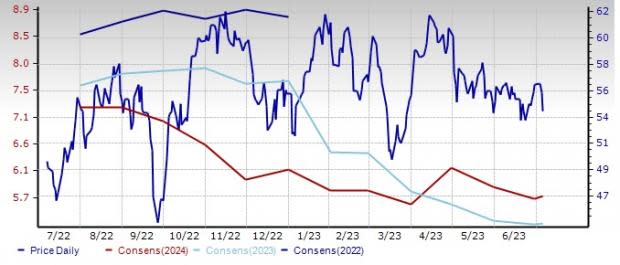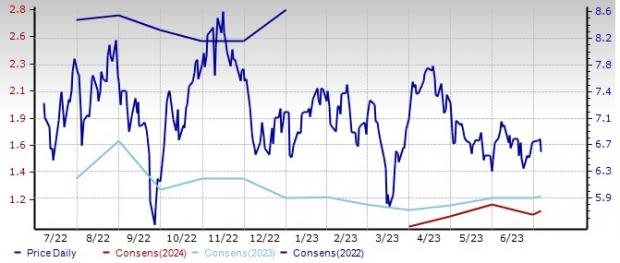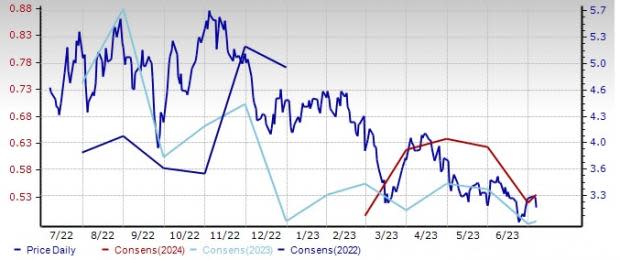3 Canadian E&P Stocks to Watch From a Turbulent Industry
Low commodity realizations are dragging down Zacks Oil and Gas - Exploration and Production - Canadian industry players’ financial performance and stock price. Concerns over slowing economic growth and lack of adequate pipeline availability continue to play their part too. Despite investor skepticism associated with these macro challenges, fortunately, there are certain companies that have held up better than others. We believe Canadian Natural Resources CNQ, Crescent Point Energy CPG and Baytex Energy BTE should be able to weather the current environment and drive future returns based on their operating efficiencies.
About the Industry
The Zacks Oil and Gas - US E&P industry consists of companies primarily based in the domestic market, focused on the exploration and production (E&P) of oil and natural gas. These firms find hydrocarbon reservoirs, drill oil and gas wells, and produce and sell these materials to be refined later into products such as gasoline, fuel oil, distillate etc. The economics of oil and gas supply and demand is the fundamental driver of this industry. In particular, a producer’s cash flow is primarily determined by realized commodity prices. In fact, all E&P companies' results are vulnerable to historically volatile prices in the energy markets. A change in realizations affects their returns and causes them to alter their production growth rates. E&P operators are also exposed to exploration risks where drilling results are comparatively uncertain.
3 Key Investing Trends to Watch in the Oil and Gas - Canadian E&P Industry
Economic Headwinds Weighing on Prices: Energy remains the worst S&P 500 sector this year. The space has witnessed a total return of (7.5%) in 2023 so far against the S&P 500’s rise of around 14.9%. Even Saudi Arabia’s surprise decision to slash output by an additional one million barrels per day from next month could not spur “black gold.” With investors dumping risky assets in the wake of concerns about a slowing global economy, WCS crude — the Canadian benchmark — has broken below the $50 threshold on more than one occasion. It’s not any different for natural gas. The fuel slumped to a 25-year low in June 2020 but hit $10 per MMBtu for the first time since 2008 in August last year. Now, it is trading below $3 on the expectation of comfortable temperatures and, therefore, lighter heating or cooling demand.
Scarcity of Pipeline: Energy consultant IHS Markit sees oil production in Canada surging by some 900,000 barrels per day during 2020-2030. Despite this impressive output growth expectation, the country's exploration and production sector has been out of favor, primarily due to the scarcity of pipelines. In short, pipeline construction in Canada has failed to keep pace with rising domestic crude volumes — the heavier sour variety churned out of the oil sands — resulting in an infrastructural bottleneck. This has forced producers to give away their products to the United States — Canada’s major market — at a discounted rate. As it is, Canadian heavy crude is inferior to the higher-quality oil extracted from shale formations in the United States and is more expensive to transport and refine. Following U.S. President Joe Biden’s revocation of TC Energy’s contentious Keystone XL pipeline and the company’s subsequent termination of the project, Canadian oil sands producers will have to wait a little longer for the takeaway capacity issue to be resolved.
Notable Shareholder Returns: The sharp increase in crude prices last year allowed the Canadian upstream operators to deliver a solid financial performance. In particular, cash from operations is on a sustainable path, with revenues improving and companies slashing capital expenditures from the pre-pandemic levels amid higher commodity realizations. To put it simply, the environment of strong prices in 2022 helped the E&P firms to generate significant “excess cash,” which they intend to use to boost investor returns. In fact, more and more energy companies are allocating their increasing cash pile by way of dividends and buybacks to pacify long-suffering shareholders.
Zacks Industry Rank Indicates Bearish Outlook
The Zacks Oil and Gas - Canadian E&P is an eight-stock group within the broader Zacks Oil - Energy sector. The industry currently carries a Zacks Industry Rank #204, which places it in the bottom 19% of more than 250 Zacks industries.
The group’s Zacks Industry Rank, which is basically the average of the Zacks Rank of all the member stocks, indicates challenging near-term prospects. Our research shows that the top 50% of the Zacks-ranked industries outperforms the bottom 50% by a factor of more than 2 to 1.
The industry’s position in the bottom 50% of the Zacks-ranked industries is a result of a negative earnings outlook for the constituent companies in aggregate. Looking at the aggregate earnings estimate revisions, it appears that analysts are becoming pessimistic about this group’s earnings growth potential. While the industry’s earnings estimates for 2023 have gone down 43.2% in the past year, the same for 2024 have fallen 61.3% over the said timeframe.
Despite the dim near-term prospects of the industry, we will present a few stocks that you may want to consider for your portfolio. But it’s worth taking a look at the industry’s shareholder returns and current valuation first.
Industry Lags Sector & S&P 500
The Zacks Oil and Gas - Canadian E&P has performed worse than the broader Zacks Oil - Energy sector as well as the Zacks S&P 500 composite over the past year.
The industry has gone down 6.9% over this period in contrast to the broader sector’s increase of 8.8% and the S&P 500’s rise of 13.8%.
One-Year Price Performance

Industry's Current Valuation
Since oil and gas companies are debt-laden, it makes sense to value them based on the Enterprise Value/ Earnings before Interest Tax Depreciation and Amortization (EV/EBITDA) ratio. This is because the valuation metric takes into account not just equity but also the level of debt. For capital-intensive companies, EV/EBITDA is a better valuation metric because it is not influenced by changing capital structures and ignores the effect of non-cash expenses.
On the basis of the trailing 12-month EV/EBITDA ratio, the industry is currently trading at 2.88X, significantly lower than the S&P 500’s 13.53X. It is, however, in line with the sector’s trailing-12-month EV/EBITDA.
Over the past five years, the industry has traded as high as 11.60X, as low as 2.47X, with a median of 4.71X, as the chart below shows.
Trailing 12-Month Enterprise Value-to EBITDA (EV/EBITDA) Ratio (Past Five Years)


Stocks in Focus
Canadian Natural Resources: This Calgary-based energy major boasts a diversified portfolio of crude oil (heavy as well as light), natural gas, bitumen and synthetic crude oil. CNQ’s balanced and diverse production mix facilitates long-term value and reduces the risk profile, thereby lending its results a high level of stability. Lower capital expenditure needs, accretive acquisitions and improving operational efficiencies are the other positives in the Canadian Natural story, which allowed the company to generate a significant free cash flow of C$10.9 billion (post capital spending and dividends) in 2022.
Notably, CNQ beat the Zacks Consensus Estimate for earnings in three of the last four quarters and missed in the other. The company has a trailing four-quarter earnings surprise of 7.4%, on average. Canadian Natural, with a Zacks Rank #3 (Hold), has seen its shares gain 9.5% in a year. You can see the complete list of today’s Zacks #1 Rank (Strong Buy) stocks here.
Price and Consensus: CNQ

Crescent Point Energy: This Calgary-based company, whose operations are primarily concentrated in southwest and southeast Saskatchewan, carries a Zacks Rank of 3. Crescent Point, which acquired Shell’s Alberta assets for C$900 million last year, counts operational excellence and prudent cost management as its strengths. With a low-risk drilling inventory of long-life assets and strong market access, CPG is also making progress on balance sheet strength and shareholder return initiatives.
Over the past 60 days, Crescent Point has seen the Zacks Consensus Estimate for 2023 move up 7%. The company enjoys a Value and Momentum Score of A each to help it round out with a VGM Score of A. With a market capitalization of around $3.7 billion, CPG has lost 6.9% in a year.
Price and Consensus: CPG

Baytex Energy: An energy producer based in Western Canada, Baytex focuses on a high-quality and diversified oil portfolio across multiple plays, spanning Peace River, Duvernay, Lloydminster and Viking. The company is also active in the Eagle Ford shale. Banking on its strong execution and disciplined capital allocation, BTE is on track to generate substantial free cash flow in this commodity upcycle. Baytex is also relentlessly working to improve its leverage ratios and enhance shareholder returns.
Headquartered in Calgary, Alberta, BTE has a trailing four-quarter earnings surprise of roughly 33%, on average. The company enjoys a Value and Momentum Score of A each to help it round out with a VGM Score of A. BTE, carrying a Zacks Rank #3, has seen its stock go down 32% in a year.
Price and Consensus: BTE

Want the latest recommendations from Zacks Investment Research? Today, you can download 7 Best Stocks for the Next 30 Days. Click to get this free report
Canadian Natural Resources Limited (CNQ) : Free Stock Analysis Report
Baytex Energy Corp (BTE) : Free Stock Analysis Report
Crescent Point Energy Corporation (CPG) : Free Stock Analysis Report
